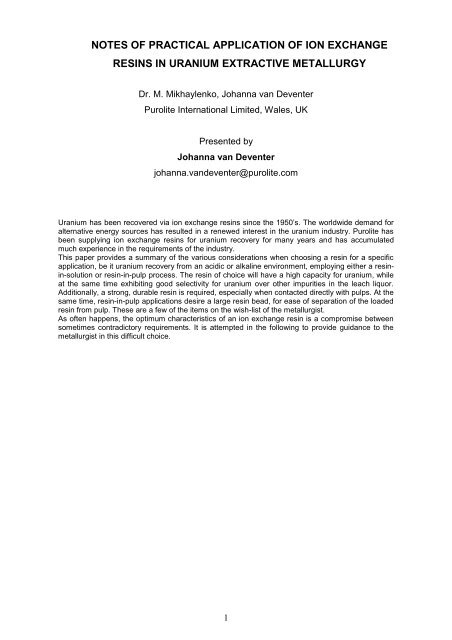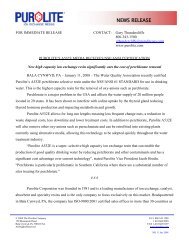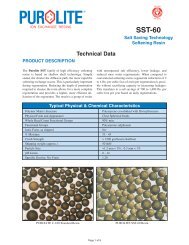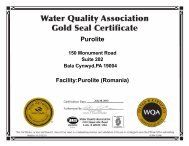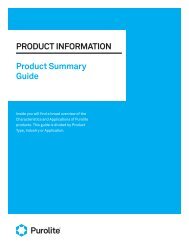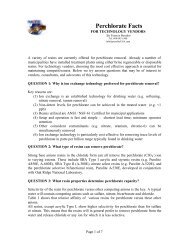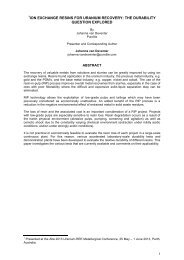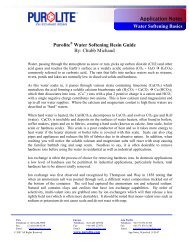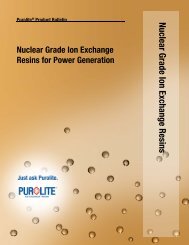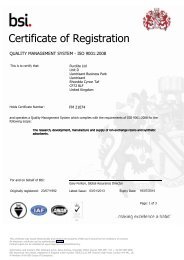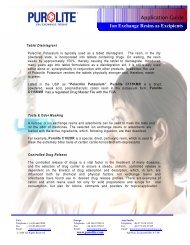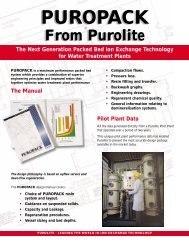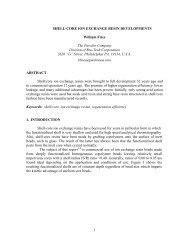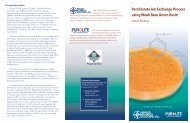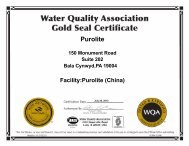Notes of practical application of ion exchange resins in ... - Purolite
Notes of practical application of ion exchange resins in ... - Purolite
Notes of practical application of ion exchange resins in ... - Purolite
- No tags were found...
Create successful ePaper yourself
Turn your PDF publications into a flip-book with our unique Google optimized e-Paper software.
South African researchers reported foul<strong>in</strong>g <strong>of</strong> an<strong>ion</strong> <strong>exchange</strong> <strong>res<strong>in</strong>s</strong> by polymerized cobalt cyanidespecies <strong>in</strong> the case <strong>of</strong> sorpt<strong>ion</strong> <strong>of</strong> uranium from acidified gold cyanidat<strong>ion</strong> tails.1.2 METHODS OF LEACHING AND SORPTIONThere are two pr<strong>in</strong>ciple methods <strong>of</strong> ore process<strong>in</strong>g: extract<strong>ion</strong> <strong>of</strong> ore from the ground (it may beunderground m<strong>in</strong>es or open pits) and <strong>in</strong> situ treatment. Extracted ore is transported, crushed,beneficiated and milled for further process<strong>in</strong>g. When <strong>in</strong> situ leach (ISL) is used, the ore rema<strong>in</strong>sunderground and uranium is dissolved by appropriate lixiviants directly from the ore body. The ISLproduces “clean” PLS with Total Suspended Solids (TSS) less than 50 ppm.Leach<strong>in</strong>g <strong>of</strong> uranium from milled ore can be arranged <strong>in</strong> the follow<strong>in</strong>g ways: Heap leach<strong>in</strong>g. This method is the most economical for process<strong>in</strong>g <strong>of</strong> low gradeores. Batch leach<strong>in</strong>g. This method can be modified as autoclave leach<strong>in</strong>g, tank leach<strong>in</strong>g,vat leach<strong>in</strong>g.For our considerat<strong>ion</strong> it is important to notice that heap leach<strong>in</strong>g and tank leach<strong>in</strong>g, followed bysedimentat<strong>ion</strong> pond and CCD respectively, produce “clean” PLS similar to those obta<strong>in</strong>ed from ISLoperat<strong>ion</strong>s.Leach<strong>in</strong>g <strong>in</strong> autoclaves or tanks produces mixtures <strong>of</strong> f<strong>in</strong>ely milled ore and PLS. Such mixtures,known as “pulps”, can be treated further <strong>in</strong> two ways:1. M<strong>in</strong>eral solids are filtered <strong>of</strong>f; clarified solut<strong>ion</strong> cont<strong>in</strong>ues to the uranium recoverystep.2. Sorpt<strong>ion</strong> <strong>of</strong> uranium is carried out directly from the pulp, def<strong>in</strong>ed as ‘res<strong>in</strong>-<strong>in</strong>-pulp’(RIP). Uranium pulp can be supplied as by-product <strong>of</strong> other metals recovery like gold (<strong>in</strong>South Africa) or copper. For some types <strong>of</strong> ores, leach<strong>in</strong>g <strong>of</strong> uranium from milled ore can becomb<strong>in</strong>ed with its sorpt<strong>ion</strong> <strong>in</strong> the same vessel, called ‘res<strong>in</strong>-<strong>in</strong>-leach’ (RIL). From standpo<strong>in</strong>t<strong>of</strong> sorpt<strong>ion</strong> technique it is very similar to RIP.2. DESIRABLE RESIN CHARACTERISTICSThe comb<strong>in</strong>at<strong>ion</strong> <strong>of</strong> different process parameters creates a variety <strong>of</strong> condit<strong>ion</strong>s for exploitat<strong>ion</strong> <strong>of</strong><strong>ion</strong> <strong>exchange</strong> <strong>res<strong>in</strong>s</strong> for uranium recovery. These condit<strong>ion</strong>s, <strong>in</strong> turn, have their reflect<strong>ion</strong>s <strong>in</strong> res<strong>in</strong>properties required for the best economical performance.The res<strong>in</strong> properties are to be chosen to suit specific work<strong>in</strong>g condit<strong>ion</strong>s. Start<strong>in</strong>g from the top <strong>of</strong> thehierarchical pyramid, the follow<strong>in</strong>g general requirements apply: High operat<strong>in</strong>g capacity Efficient regenerat<strong>ion</strong> Service life durabilityEach <strong>of</strong> these requirements splits on to lower levels:High operat<strong>in</strong>g capacity means: High chemical aff<strong>in</strong>ity <strong>of</strong> the res<strong>in</strong> funct<strong>ion</strong>al groups towards uranyl compounds4
High selectivity <strong>of</strong> the funct<strong>ion</strong>al groups towards uranyl compounds; i.e. loweraff<strong>in</strong>ity for undesirable species present <strong>in</strong> the feed source High k<strong>in</strong>etics <strong>of</strong> <strong>ion</strong> <strong>exchange</strong>, both dur<strong>in</strong>g adsorpt<strong>ion</strong> and elut<strong>ion</strong>The follow<strong>in</strong>g properties def<strong>in</strong>e the efficiency <strong>of</strong> regenerat<strong>ion</strong>: Applicability <strong>of</strong> available reagents Obta<strong>in</strong><strong>in</strong>g <strong>of</strong> lower volume <strong>of</strong> more concentrated desorbates Prevent<strong>ion</strong> <strong>of</strong> foul<strong>in</strong>g impurities build-up Low residual content <strong>of</strong> uranium <strong>in</strong> the regenerated res<strong>in</strong>The service life durability is def<strong>in</strong>ed by the follow<strong>in</strong>g ma<strong>in</strong> factors: Mechanical strength Resistance to chemical foul<strong>in</strong>g or degradat<strong>ion</strong> Resistance to osmotic shockAs always, the optimum characteristics <strong>of</strong> an <strong>ion</strong> <strong>exchange</strong> res<strong>in</strong> is a compromise betweensometimes contradictory requirements. It means that to enforce one specific property <strong>of</strong> the res<strong>in</strong>we have to sacrifice some others. To ensure the best res<strong>in</strong> for a particular project is chosen, allthese aspects have to be considered. This can be a daunt<strong>in</strong>g task. Some <strong>of</strong> the res<strong>in</strong> requirementsare discussed <strong>in</strong> more detail below.1.3 OPERATING CAPACITY OF THE RESINOver the years, many types <strong>of</strong> <strong>ion</strong> <strong>exchange</strong> <strong>res<strong>in</strong>s</strong> have been tried for the extract<strong>ion</strong> <strong>of</strong> uranium.However, so far only strong base an<strong>ion</strong> <strong>exchange</strong> <strong>res<strong>in</strong>s</strong> are widely used across the world to extractnatural uranium (both type I and type II). Though some authors advocate different performance <strong>of</strong>these two res<strong>in</strong> types, <strong>Purolite</strong> has not observed any mean<strong>in</strong>gful difference. In further narrat<strong>ion</strong>, nodifferentiat<strong>ion</strong> is made between these types <strong>of</strong> SBA <strong>res<strong>in</strong>s</strong>.Uranium operat<strong>in</strong>g capacity <strong>of</strong> SBA <strong>res<strong>in</strong>s</strong> changes <strong>in</strong> correspondence with their total capacitydef<strong>in</strong>ed for the chloride-an<strong>ion</strong>, as shown <strong>in</strong> Figure 1.The data illustrated <strong>in</strong> Figure 1 was generated for sulfuric acid artificial PLS with a uraniumconcentrat<strong>ion</strong> <strong>of</strong> 100 mg/L. This dependence is more or less accurate for all typical SBA <strong>res<strong>in</strong>s</strong> used<strong>in</strong> the <strong>in</strong>dustry.It becomes clear that gel type <strong>res<strong>in</strong>s</strong>, due to their higher volume capacity, will generally have higheruranium capacities than porous <strong>res<strong>in</strong>s</strong>.The uranium load<strong>in</strong>g capacity <strong>of</strong> a res<strong>in</strong> with common strong base groups is limited. <strong>Purolite</strong> has<strong>in</strong>troduced a new products l<strong>in</strong>e <strong>of</strong> SBA <strong>res<strong>in</strong>s</strong> employ<strong>in</strong>g a different quaternary ammoniumfunct<strong>ion</strong>al group. These new products exhibit much higher uranium load<strong>in</strong>gs, when compared tores<strong>in</strong> with convent<strong>ion</strong>al funct<strong>ion</strong>al groups. Data <strong>in</strong> Table 1 compare the uranium load<strong>in</strong>g capacities<strong>of</strong> these new <strong>res<strong>in</strong>s</strong>, both gel-type and macroporous, to that obta<strong>in</strong>ed for convent<strong>ion</strong>al res<strong>in</strong>.5
Uranium Uptake, g per litre5550Experimental DataPolynomial Fit for the Experimental DataUpper 95% Confidence LimitLower 95% Confidence Limit45403530Y =95.00316-131.17227 X+60.47479 X 2251.40 1.45 1.50 1.55 1.60 1.65 1.70 1.75Volume Capacity, eq/litre [Cl - ]Figure 1: Dependence <strong>of</strong> uranium uptake on chloride capacity <strong>of</strong> strong base an<strong>ion</strong> gelType I res<strong>in</strong> (<strong>Purolite</strong> ® ).Table 1 represents data on uranium fixat<strong>ion</strong> obta<strong>in</strong>ed under the same condit<strong>ion</strong>s as for Figure 1. Itis remarkable that while res<strong>in</strong> no. 1 with common strong base an<strong>ion</strong> groups matches theapproximat<strong>ion</strong> curve pretty well, the other SBA <strong>res<strong>in</strong>s</strong>, numbers 2, 3 and 4 hav<strong>in</strong>g differentquaternary ammonium groups demonstrate much higher uranium load<strong>in</strong>gs.Table 1 Uranium fixat<strong>ion</strong> on <strong>res<strong>in</strong>s</strong> with different funct<strong>ion</strong>alityIon <strong>exchange</strong> res<strong>in</strong> Total volume capacityper chloride, eq/lUraniumfixat<strong>ion</strong>, g/lRatio <strong>of</strong> U fixat<strong>ion</strong> tochloride capacity, g/eq1 PFA600/4740 (gel) a 1.63 39.8 24.42 A560/4758 (porous) b 1.18 46.7 39.63 A660/4759 (gel) b 1.45 53.0 36.64 PFA460/4783 (porous) b 1.37 55.0 40.2a – convent<strong>ion</strong>alb – “new”Even porous <strong>Purolite</strong> ® A560/4758 res<strong>in</strong> with the lowest chloride capacity has higher uranium fixat<strong>ion</strong>than common gel type PFA600/4740.Higher operat<strong>in</strong>g capacity presents to the user such advantages as: Lower res<strong>in</strong> flow rate Less res<strong>in</strong> <strong>in</strong>ventory and less capital expenditure (CAPEX) <strong>of</strong> the project Less operat<strong>in</strong>g expenditures (OPEX) related to auxiliary operat<strong>ion</strong>s associated with theres<strong>in</strong> flow rate: res<strong>in</strong> losses, energy, r<strong>in</strong>s<strong>in</strong>g waters, wastes, man power etcFor further comparison, as shown <strong>in</strong> Table 2, three <strong>Purolite</strong> ®<strong>res<strong>in</strong>s</strong> were <strong>in</strong>vestigated <strong>in</strong> thelaboratory on the solut<strong>ion</strong> <strong>of</strong> the follow<strong>in</strong>g composit<strong>ion</strong> (g/l): Uranium – 0.104; Sulfate – 10.5; Nitrate6
– 0.50; Chloride – 1.05; Fe 3+ – 1.02; Al 3+ – 0.35; Si – 0.06; pH = 2.0. Such solut<strong>ion</strong> simulates typicalpregnant solut<strong>ion</strong> produced by sulfuric acid ISL operat<strong>ion</strong>s. The <strong>res<strong>in</strong>s</strong> tested were: A500U/2788: macroporous, size distribut<strong>ion</strong> 800-1300 µm (92% >800 µm), “convent<strong>ion</strong>al”product PFA460/4783: gel-type, uniform beads, size distribut<strong>ion</strong> 520 – 630 µm, “new” product PFA600/4740: gel-type, uniform beads, size distribut<strong>ion</strong> 520 – 630 µm, “convent<strong>ion</strong>al” productTable 2 Comparison <strong>of</strong> general sorpt<strong>ion</strong> parameters for different strong base an<strong>ion</strong> <strong>res<strong>in</strong>s</strong><strong>Purolite</strong> ® <strong>res<strong>in</strong>s</strong>A 500U/2788 a PFA460/4783 b PFA600/4740 aSorpt<strong>ion</strong> time till breakthrough po<strong>in</strong>t, hours 5.90 17.0 14.2Uranium fixat<strong>ion</strong> on the res<strong>in</strong> at breakthroughpo<strong>in</strong>t, g/la – convent<strong>ion</strong>alb – “new”5.46 15.7 13.1The laboratory results obta<strong>in</strong>ed were used to calculate the sorpt<strong>ion</strong> time till breakthrough po<strong>in</strong>t(accepted for uranium as 0.002 g/l) and the res<strong>in</strong> capacities at the breakthrough po<strong>in</strong>t for a full-scaleplant; it was accepted that fixed bed filter has diameter 4 m, res<strong>in</strong> bed volume is 28.6 m 3 and feedflow rate is 259 m 3 /hour.The results presented <strong>in</strong> Table 2 showed that the time until uranium breakthrough for “new”PFA460/4783 res<strong>in</strong> was about 20% more, and uranium fixat<strong>ion</strong> was also 20% more than forcommon PFA600/4740 at the same res<strong>in</strong> bed volume and PLS flow rate. The uranium load<strong>in</strong>gobta<strong>in</strong>ed was almost three times higher for the “new” PFA460/4783 than for “convent<strong>ion</strong>al”A500U/2788, with a similar <strong>in</strong>crease <strong>in</strong> the time till breakthrough.1.4 RESIN LOSSESOne <strong>of</strong> the most frequent quest<strong>ion</strong>s is about res<strong>in</strong> losses rate.Res<strong>in</strong> leaves the process loop generally with flows <strong>of</strong> barren pulp or solut<strong>ion</strong>; we can nom<strong>in</strong>ate suchlosses as ‘technological’ ones. Some losses can also be are attributed to mishandl<strong>in</strong>g, spillage etc.Under normal process condit<strong>ion</strong>s, res<strong>in</strong> breaks down to produce f<strong>in</strong>e particles which pass throughthe screen<strong>in</strong>g circuits.Res<strong>in</strong> breaks down due to different physical forces: compress<strong>ion</strong> failure percussive act<strong>ion</strong> abras<strong>ion</strong> osmotic shockLet’s consider them separately.Compress<strong>ion</strong> failure is more typical for <strong>res<strong>in</strong>s</strong> work<strong>in</strong>g <strong>in</strong> columns <strong>in</strong> fixed beds. This is the mostcommon design for <strong>in</strong>-situ and heap leach operat<strong>ion</strong>. In the fixed beds the res<strong>in</strong> is exposed to al<strong>in</strong>ear pressure gradient attributed to solut<strong>ion</strong> flow along the column axis.7
Perfect beads (%)100806040200300 350 400 450 500 550 600 650 700Break<strong>in</strong>g weight (g/bead)Figure 2: Relat<strong>ion</strong> between ball mill and dynamometric tests (<strong>Purolite</strong> © .)It is <strong>in</strong>terest<strong>in</strong>g to notice that break<strong>in</strong>g weight and ball mill parameters don’t necessarily collate, asillustrated by Figure 2. The break<strong>in</strong>g weights <strong>of</strong> a number <strong>of</strong> <strong>res<strong>in</strong>s</strong> were compared to the results <strong>of</strong>the Ball Mill test.It is logical to assume that res<strong>in</strong> wear rate is l<strong>in</strong>ked with res<strong>in</strong> flow rate <strong>in</strong> the process. Higher res<strong>in</strong>flow rates will result <strong>in</strong> higher collis<strong>ion</strong>s frequency, collis<strong>ion</strong> momentum and frequency <strong>of</strong>regenerat<strong>ion</strong>s. The comb<strong>in</strong>ed effect <strong>of</strong> these will result <strong>in</strong> <strong>in</strong>creased breakage <strong>of</strong> the res<strong>in</strong>.Res<strong>in</strong> flow rate is determ<strong>in</strong>ed by uranium mass balance <strong>of</strong> the process. Metal flow (kg/hour) throughthe plant must be equilibrated by flow <strong>of</strong> res<strong>in</strong> <strong>exchange</strong> capacity. The latter is def<strong>in</strong>ed asmultiplicat<strong>ion</strong> <strong>of</strong> res<strong>in</strong> operat<strong>in</strong>g capacity (kg/m 3 R ) by res<strong>in</strong> flow (m 3 R /hour). Thus we see that <strong>res<strong>in</strong>s</strong>with higher operat<strong>in</strong>g capacity have advantage due to less wear rate, other condit<strong>ion</strong>s be<strong>in</strong>g equal.Averaged res<strong>in</strong> losses reported by operat<strong>in</strong>g uranium RIP plants are 175-220 g <strong>of</strong> dry res<strong>in</strong> per 1tonne <strong>of</strong> treated ore or about 60-80 m 3 res<strong>in</strong> per 100 thousand tones <strong>of</strong> treated ore. It representsabout 20% make-up <strong>of</strong> the total res<strong>in</strong> <strong>in</strong>ventory. Actual make-up can vary from 15 to 45%depend<strong>in</strong>g on different operat<strong>in</strong>g parameters.1.5 GRADING OF RESINGrad<strong>in</strong>g <strong>of</strong> <strong>ion</strong> <strong>exchange</strong> <strong>res<strong>in</strong>s</strong> will comply with the follow<strong>in</strong>g demands: Effective separat<strong>ion</strong> from productive leach media, either, clean solut<strong>ion</strong> or dense pulp. Low hydrodynamic resistance by res<strong>in</strong> bed to solut<strong>ion</strong> flow <strong>in</strong> fixed beds (low pressure dropacross the bed). This is provided by narrow size distribut<strong>ion</strong> <strong>of</strong> the res<strong>in</strong> beads.<strong>Purolite</strong> produces <strong>res<strong>in</strong>s</strong> with different grad<strong>in</strong>g depend<strong>in</strong>g on particular <strong>applicat<strong>ion</strong></strong>: Pur<strong>of</strong><strong>in</strong>e grade: mean diameter 520-620 μm with uniformity coefficient 1.2 max. Special grade for RIP processes: 1% max below 710 μm and 5% max below 800 μm.9
1.6 POLYMER MATRIX AND MOISTURE RETENTIONMost <strong>of</strong> the commercial <strong>res<strong>in</strong>s</strong> suggested on the world market are made <strong>of</strong> styrene as a monomerand div<strong>in</strong>ylbenzene (DVB) as a crossl<strong>in</strong>ker. Structure <strong>of</strong> the <strong>res<strong>in</strong>s</strong> can be either gel or porous.Characteristics <strong>of</strong> porous structure depend on the res<strong>in</strong> manufactur<strong>in</strong>g method.Be<strong>in</strong>g funct<strong>ion</strong>alized with quaternary ammonium the res<strong>in</strong> becomes very hydrophilic. It reta<strong>in</strong>s waterdue to hydrat<strong>ion</strong> and coord<strong>in</strong>at<strong>ion</strong> via hydrogen bond<strong>in</strong>g. Typically such water retent<strong>ion</strong> varies fordifferent <strong>res<strong>in</strong>s</strong> from 45 to 60% depend<strong>in</strong>g on the extent <strong>of</strong> res<strong>in</strong> crossl<strong>in</strong>k<strong>in</strong>g and the concentrat<strong>ion</strong><strong>of</strong> funct<strong>ion</strong>al groups <strong>in</strong> the polymer matrix.Porosity, extent <strong>of</strong> crossl<strong>in</strong>k<strong>in</strong>g and moisture retent<strong>ion</strong> capacity play an important role <strong>in</strong> operat<strong>in</strong>gperformance under real condit<strong>ion</strong>s. Comb<strong>in</strong>at<strong>ion</strong> <strong>of</strong> these parameters def<strong>in</strong>es operat<strong>in</strong>g capacity <strong>of</strong>the res<strong>in</strong>, rate <strong>of</strong> <strong>ion</strong> <strong>exchange</strong> react<strong>ion</strong>, osmotic and mechanical resistance, and resistance to silicafoul<strong>in</strong>g.Eventually, optimized performance is a trade-<strong>of</strong>f among these parameters.High k<strong>in</strong>etics <strong>of</strong> <strong>exchange</strong> is an important parameter which has great <strong>in</strong>fluence on res<strong>in</strong>performance especially for PLS <strong>of</strong> low grade as <strong>of</strong> restorat<strong>ion</strong> wells for example. For process<strong>in</strong>g <strong>of</strong>low grade solut<strong>ion</strong>s, say below 30 ppm <strong>of</strong> uranium, the macroporous or low-crossl<strong>in</strong>ked gel <strong>res<strong>in</strong>s</strong>are preferable, due to their higher k<strong>in</strong>etics and total efficiency.For high grade solut<strong>ion</strong>s, convent<strong>ion</strong>ally above 50-60 ppm, higher res<strong>in</strong> capacity is preferable. Gel<strong>res<strong>in</strong>s</strong> typically have higher total capacity than macroporous <strong>res<strong>in</strong>s</strong>. For example, total capacity asper chloride an<strong>ion</strong> is around 1.2 eq/l for <strong>Purolite</strong> ® A500U/2788 (macroporous) and 1.6 eq/l for<strong>Purolite</strong> ® PFA600/4740 (gel-type) res<strong>in</strong>.1.7 SILICA FOULINGSilica foul<strong>in</strong>g rema<strong>in</strong>s one <strong>of</strong> the ma<strong>in</strong> concerns when a new project is <strong>in</strong>vestigated. The chemicalbehavior <strong>of</strong> silica is complicated and difficult to control.Silica foul<strong>in</strong>g issues are typical for acid leach condit<strong>ion</strong>s. It is known that silica tends topolycondensat<strong>ion</strong> at acidic pH with format<strong>ion</strong> <strong>of</strong> large polymeric molecules which <strong>in</strong> turn formcolloidal particles. Thus, <strong>in</strong> acidic solut<strong>ion</strong> we face monomeric an<strong>ion</strong>ic forms <strong>of</strong> silica as well aspolymerized and colloidal forms. Reported solubility <strong>of</strong> monomeric silica is around 300 ppm. In realproductive leach media silica concentrat<strong>ion</strong>s can range from about 400 to 2,000 ppm.Monomeric form <strong>of</strong> silica has low aff<strong>in</strong>ity for strong base funct<strong>ion</strong>ality <strong>of</strong> the res<strong>in</strong>. It can be easilyremoved from the res<strong>in</strong> at uranium desorpt<strong>ion</strong> stage. It is assumed that all forms <strong>of</strong> silica exist<strong>in</strong>g <strong>in</strong>the solut<strong>ion</strong> participate <strong>in</strong> the foul<strong>in</strong>g process.It is known that the rate <strong>of</strong> silica accumulat<strong>ion</strong> on the res<strong>in</strong> is much higher for macroporous <strong>res<strong>in</strong>s</strong>than for gel <strong>res<strong>in</strong>s</strong>. An operat<strong>in</strong>g RIP plant us<strong>in</strong>g acid leach has reported results obta<strong>in</strong>ed <strong>in</strong> 30sorpt<strong>ion</strong>-desorpt<strong>ion</strong> cycles us<strong>in</strong>g real solut<strong>ion</strong>: silica accumulat<strong>ion</strong> for a gel res<strong>in</strong> was 1.1 w. w. %while for macroporous res<strong>in</strong> it was 17.4 w.% after 30 cycles. Silica concentrat<strong>ion</strong> <strong>in</strong> the feed solut<strong>ion</strong>was about 2 g/l.Silica build-up drastically affects the rate <strong>of</strong> uranium sorpt<strong>ion</strong> and, consequently, the operat<strong>in</strong>gcapacity <strong>of</strong> the res<strong>in</strong>. When the foul<strong>in</strong>g reaches some critical value the res<strong>in</strong> may be treated by10
U (g/l)alkali to convert the silica to the soluble form and strip it from the res<strong>in</strong>. Ideally such treatmentshould be organized as kidney loop system provid<strong>in</strong>g the same rate <strong>of</strong> silica withdrawal as it’s builduprate is. The silica build-up rate should be def<strong>in</strong>ed at the pilot stage <strong>of</strong> a project.Real data <strong>of</strong> dependence <strong>of</strong> uranium uptake on silica build-up is depicted <strong>in</strong> Figure 3. Samples <strong>of</strong>the res<strong>in</strong> were taken from the process over the course <strong>of</strong> a few months. It should be ment<strong>ion</strong>ed thatfresh res<strong>in</strong> was added to the process dur<strong>in</strong>g this time, to ensure the desired res<strong>in</strong> concentrat<strong>ion</strong> wasma<strong>in</strong>ta<strong>in</strong>ed.When mak<strong>in</strong>g a decis<strong>ion</strong> regard<strong>in</strong>g the <strong>in</strong>stallat<strong>ion</strong> <strong>of</strong> an alkal<strong>in</strong>e treatment circuit, one should keep35343332313029282730 31 32 33 34 35 36 37 38SiO2 (%)Figure 3: Dependence <strong>of</strong> uranium sorpt<strong>ion</strong> on silica build-up on a macroporous res<strong>in</strong>, year 1999.<strong>in</strong> m<strong>in</strong>d that uranium capacity loss attributed to silica foul<strong>in</strong>g can be compensated by fresh res<strong>in</strong> topupwhich is necessary to do because <strong>of</strong> the res<strong>in</strong> wear. So, if silica foul<strong>in</strong>g rate isn’t too fast, it ispossible to avoid alkal<strong>in</strong>e treatment.In practice, under reasonable condit<strong>ion</strong>s, the alkal<strong>in</strong>e process allows to strip about 20-25% <strong>of</strong> silicafrom heavily fouled macroporous res<strong>in</strong> per treatment. Obviously, <strong>in</strong> case <strong>of</strong> gel res<strong>in</strong> silica can bestripped more efficiently for two reasons: less foul<strong>in</strong>g; silica is layered ma<strong>in</strong>ly on external surface <strong>of</strong> res<strong>in</strong> beads.One property is <strong>in</strong> favor <strong>of</strong> macroporous <strong>res<strong>in</strong>s</strong>: they are more resistant to osmotic shock caused byalkal<strong>in</strong>e treatment.1.8 SORPTION FROM “CLEAN” SOLUTIONSClean PLS can be based on different chemical background: acid, bi- or carbonate leach. In practicesuch solut<strong>ion</strong>s conta<strong>in</strong> about 50 ppm and less <strong>of</strong> suspended solids. This fact must be consideredwhen sorpt<strong>ion</strong> contactor design is to be chosen.So, if fixed bed is chosen then it is necessary to provide shorter sorpt<strong>ion</strong> service with backwash<strong>in</strong>g<strong>of</strong> the res<strong>in</strong> to remove entrapped f<strong>in</strong>es.11
Designs with mov<strong>in</strong>g or fluidized bed are preferable, s<strong>in</strong>ce these designs negate problems withpressure drop <strong>in</strong>crease and provide excellent productivity.Gel <strong>res<strong>in</strong>s</strong> with narrow bead size distribut<strong>ion</strong> with mean diameter about 570 μm have a wellestablished reputat<strong>ion</strong> for sorpt<strong>ion</strong> from clean solut<strong>ion</strong>s. Their ma<strong>in</strong> advantages are good k<strong>in</strong>etics <strong>of</strong><strong>ion</strong> <strong>exchange</strong> and low specific pressure drop across the bed.Choice <strong>of</strong> res<strong>in</strong> structure depends on the chemistry <strong>of</strong> particular PLS. One should remember aboutpossible silica issues and chemical stability <strong>of</strong> the res<strong>in</strong>.3. RESIN IN PULP AND RESIN IN LEACH PROCESSESSorpt<strong>ion</strong> from pulps makes specific demands for res<strong>in</strong> choice. Ore pulps used for sorpt<strong>ion</strong> contactcan bear up to 50-55 w.% <strong>of</strong> solids. Comm<strong>in</strong>ut<strong>ion</strong> grade <strong>of</strong> the ore (mill<strong>in</strong>g f<strong>in</strong>eness) shall be def<strong>in</strong>edas trade-<strong>of</strong>f between costs <strong>of</strong> mill<strong>in</strong>g and leach<strong>in</strong>g efficiency.In practice the f<strong>in</strong>eness <strong>of</strong> m<strong>in</strong>eral solids <strong>in</strong> pulp is 90-95% smaller than 75 µm and the balance isless than 150 µm. These parameters def<strong>in</strong>e total open<strong>in</strong>gs <strong>of</strong> mesh screens which must securedesigned pulp flow. In reality the open<strong>in</strong>g is 600 µm. For effective separat<strong>ion</strong> <strong>of</strong> res<strong>in</strong> from pulp theres<strong>in</strong> must be about 200 µm bigger than the mesh open<strong>in</strong>g.<strong>Purolite</strong>’s specificat<strong>ion</strong>s on all <strong>res<strong>in</strong>s</strong> dedicated to RIP or RIL processes have less than 1% below710 µm and less than 5% below 800 µm.4. BY-VALUES RECOVERYUranium ores may conta<strong>in</strong> different by-metals or it can be recovered as a by-metal itself. A group <strong>of</strong>major by-metals can <strong>in</strong>clude such elements as gold, vanadium, and molybdenum. A group <strong>of</strong> m<strong>in</strong>ormetals is wider and can <strong>in</strong>clude metals from the first group and others, for example rhenium,scandium, yttrium and rare earths.When the potential value <strong>of</strong> by-metals <strong>in</strong> processed flows is significant it is worth <strong>of</strong> considerat<strong>ion</strong> <strong>of</strong>their recovery. The Witwatersrand gold-bear<strong>in</strong>g ores <strong>in</strong> South Africa conta<strong>in</strong>s, apart from gold,uranium <strong>in</strong> economical quantities (typical head grades 100-500 g/t). Dur<strong>in</strong>g the previous uraniumboom <strong>in</strong> the 1970’s and 1980’s, uranium was recovered as a by-product <strong>of</strong> gold at 27 different sites.Initially, acid leach<strong>in</strong>g followed cyanidat<strong>ion</strong>, ma<strong>in</strong>ly s<strong>in</strong>ce this <strong>in</strong>volved no change to the exist<strong>in</strong>g goldcircuits. Further research showed that improved gold recovery could be achieved by perform<strong>in</strong>g theacid leach first, to extract uranium, followed by neutralizat<strong>ion</strong> and cyanidat<strong>ion</strong> to recover gold. Thissequence was known as the “reverse leach”. A further advantage <strong>of</strong> the reverse leach was that itprevented poison<strong>in</strong>g <strong>of</strong> the res<strong>in</strong> by cobalt cyanide.We will consider two cases <strong>of</strong> by-metals recovery <strong>in</strong> more detail.1.9 VANADIUMIn process<strong>in</strong>g <strong>of</strong> vanadium-uranium ores the vanadium is usually present as a major by-metal.When uranium is leached by sulfuric acid or carbonate lixiviant the vanadium is also oxidized to the5 + state and co-extracted <strong>in</strong>to the PLS as vanadate oxoan<strong>ion</strong> together with uranium. In some cases12
Metal fixat<strong>ion</strong>, mg/g353025201510UV500 1 2 3 4 5 6Time <strong>of</strong> sorpt<strong>ion</strong>, hoursFigure 4: K<strong>in</strong>etic curves for sorpt<strong>ion</strong> <strong>of</strong> uranium and vanadium by strong baseres<strong>in</strong> <strong>Purolite</strong> ® PFA600/4740 from simulat<strong>in</strong>g PLS.the ratio <strong>of</strong> uranium and vanadium <strong>in</strong> the PLS can be as high as 1 to 1. Both metals are efficientlyadsorbed by strong base an<strong>ion</strong> <strong>res<strong>in</strong>s</strong>, hence, their separat<strong>ion</strong> can create difficulties for product<strong>ion</strong><strong>of</strong> pure uranium oxide.One <strong>of</strong> the available opt<strong>ion</strong>s for the “vanadium” problem is reduct<strong>ion</strong> <strong>of</strong> the element to the 4 + state <strong>in</strong>the PLS. In this oxidat<strong>ion</strong> state, vanadium will be present as a cat<strong>ion</strong> and will not be fixed by strongbase an<strong>ion</strong> <strong>exchange</strong> <strong>res<strong>in</strong>s</strong>. This approach requires high accuracy as uranium must be kept <strong>in</strong> its6 + state. It also requires a significant expans<strong>ion</strong> <strong>of</strong> the flowsheet, mak<strong>in</strong>g it an unattractive opt<strong>ion</strong> <strong>in</strong>practice.Guaranteed purificat<strong>ion</strong> <strong>of</strong> uranium oxide with a lot <strong>of</strong> vanadium contam<strong>in</strong>at<strong>ion</strong> usually results <strong>in</strong>relatively high losses <strong>of</strong> uranium.<strong>Purolite</strong> has done test work that showed that the separat<strong>ion</strong> <strong>of</strong> bulk vanadium from uranium PLScan be achieved by one step sorpt<strong>ion</strong> on the same res<strong>in</strong> which can be used for downstreamsorpt<strong>ion</strong> <strong>of</strong> uranium. The method is based on the significant difference <strong>in</strong> sorpt<strong>ion</strong> k<strong>in</strong>etics for thesetwo metals on the strong base, gel type res<strong>in</strong> <strong>Purolite</strong> ® PFA600/4740.Artificial solut<strong>ion</strong> with the follow<strong>in</strong>g composit<strong>ion</strong> was used (g/l): uranium – 0.5; V 5+ - 0.34; CO 2- 3 --2-13.5; HCO 3 - 6.5; SO 4 - 5.8. The alkal<strong>in</strong>ity <strong>of</strong> the solut<strong>ion</strong> was adjusted by NaOH to pH 9.6.Contact <strong>of</strong> the res<strong>in</strong> with the solut<strong>ion</strong> was carried out <strong>in</strong> five beakers with ratio <strong>of</strong> res<strong>in</strong> to solut<strong>ion</strong> <strong>of</strong>1 to 1000 (by volume). The obta<strong>in</strong>ed k<strong>in</strong>etic curves are depicted on the Figure 4. One can see thattime till maximal load<strong>in</strong>g <strong>of</strong> vanadium was about 1.5 hours while for uranium load<strong>in</strong>g about 4 hourswere required.Process<strong>in</strong>g <strong>of</strong> obta<strong>in</strong>ed k<strong>in</strong>etic data allowed to f<strong>in</strong>d optimal parameters for separat<strong>ion</strong> <strong>of</strong> vanadiumfrom the uranium stream. The calculat<strong>ion</strong> were made for columns <strong>of</strong> mov<strong>in</strong>g bed design, with<strong>in</strong>ternal diameter 3 m and the PLS flow rate 250 m 3 /hour. The goal was to decrease theconcentrat<strong>ion</strong> <strong>of</strong> vanadium <strong>in</strong> the PLS to < 10 mg/l.The calculated parameters <strong>of</strong> the process were as follows:13
- Each 4 hours 20.2 m 3 <strong>of</strong> the res<strong>in</strong> is <strong>of</strong>f-loaded from the bottom <strong>of</strong> the column (atthe same time, a similar volume <strong>of</strong> fresh res<strong>in</strong> is added to the top <strong>of</strong> the column).- Metal fixat<strong>ion</strong>s <strong>in</strong> the <strong>of</strong>f-loaded res<strong>in</strong> are about 12.4 kg Vanadium/m 3 and 0.24 kgUranium/m 3 .- Metal concentrat<strong>ion</strong>s <strong>in</strong> the outlet solut<strong>ion</strong> are about 0.01 g Vanadium/l and 0.39 gUranium/l (for the latter 97.5% <strong>of</strong> the feed concentrat<strong>ion</strong>).This simple flowsheet can separate a vanadium/uranium composite stream <strong>in</strong>to two s<strong>in</strong>gle metalstreams. This is a tra<strong>in</strong> <strong>of</strong> two columns; while the lead column hav<strong>in</strong>g higher res<strong>in</strong> flow rate removesvanadium, the lag column with slower res<strong>in</strong> flow recovers uranium from the vanadium depletedPLS. Both lead and lag columns use the same type <strong>of</strong> res<strong>in</strong>, i.e. <strong>Purolite</strong> ® PFA600/4740. The ma<strong>in</strong>advantage <strong>of</strong> such a flowsheet is that it allows downstream process<strong>in</strong>g <strong>of</strong> vanadium and uraniumstreams separately and <strong>in</strong>dependently. This method <strong>of</strong> vanadium separat<strong>ion</strong> requires m<strong>in</strong>imalcapital costs.1.10 RHENIUMRhenium is among a group <strong>of</strong> scattered metals which don’t have their own m<strong>in</strong>eral deposits but<strong>of</strong>ten accompany other metals. In many cases rhenium is leached together with uranium from theores. In contrary to the case <strong>of</strong> vanadium considered above, rhenium always belongs to the group<strong>of</strong> m<strong>in</strong>or by-metals: its concentrat<strong>ion</strong> <strong>in</strong> uranium PLS rarely exceeds 5 ppm, typically it is below 1ppm.It is worth to consider the rhenium by-recovery <strong>in</strong> many cases, when tak<strong>in</strong>g <strong>in</strong> considerat<strong>ion</strong> suchfactors ashigh demand for rhenium from turb<strong>in</strong>e build<strong>in</strong>g and oil process<strong>in</strong>g <strong>in</strong>dustries,high price <strong>of</strong> this metal,significant volumes <strong>of</strong> the uranium PLS processed.Rhenium is easily leached by sulfuric acid as the perrhenate an<strong>ion</strong> (ReO - 4 ). In contrast to vanadiumthe strong base <strong>res<strong>in</strong>s</strong> commonly used for uranium sorpt<strong>ion</strong>, adsorb rhenium much slower thanuranium. For one uranium sorpt<strong>ion</strong> cycle about 90% <strong>of</strong> feed rhenium passes through the res<strong>in</strong> bedand reports to the uranium barren solut<strong>ion</strong>. The fixed 10% or less <strong>of</strong> rhenium is not stripped fromthe res<strong>in</strong> at uranium desorpt<strong>ion</strong> stage. Thus, rhenium is accumulated <strong>in</strong> the strong base an<strong>ion</strong><strong>exchange</strong>r with time. Some operators periodically strip the adsorbed rhenium by concentrated nitricacid, generat<strong>in</strong>g large volumes <strong>of</strong> diluted rhenium desorbate.<strong>Purolite</strong> has commercialized the weak base an<strong>ion</strong> <strong>exchange</strong> res<strong>in</strong> <strong>Purolite</strong>® A170/4675, which isvery selective for the perrhenate an<strong>ion</strong>. This res<strong>in</strong> has been <strong>in</strong>stalled by several operators whorecover rhenium from different raw sources. Particularly, one commercial <strong>in</strong>stallat<strong>ion</strong> has beenmade by a uranium ISL operator us<strong>in</strong>g acid leach. The general flowsheet for this <strong>in</strong>stallat<strong>ion</strong> isdepicted <strong>in</strong> Figure 5.14
2Sorpt<strong>ion</strong> <strong>of</strong>uranium onSBA res<strong>in</strong>Desorpt<strong>ion</strong><strong>of</strong> uraniumfrom SBAres<strong>in</strong>Sorpt<strong>ion</strong> anddesorpt<strong>ion</strong> <strong>of</strong>Re on/from<strong>Purolite</strong> ®A170/4675614351 – Uranium PLS from the well field;2 – Uranium barren solut<strong>ion</strong> as the rhenium feed flow to rhenium circuit;3 – Res<strong>in</strong> treatment circle <strong>in</strong> uranium extract<strong>ion</strong>;4 – Barren solut<strong>ion</strong> back to well field after acid adjustment;5 – Aqueous ammonia solut<strong>ion</strong> for rhenium desorpt<strong>ion</strong>;6 – Rhenium desorbate for further concentrat<strong>in</strong>g, crystallizat<strong>ion</strong> andpack<strong>in</strong>g.Figure 5: General flowsheet for recovery <strong>of</strong> rhenium from uranium barren solut<strong>ion</strong>.The advantage <strong>of</strong> this scheme is <strong>in</strong> its m<strong>in</strong>imal affect on the ma<strong>in</strong> process <strong>of</strong> uranium extract<strong>ion</strong>.Uranium barren solut<strong>ion</strong> passes through the column with <strong>Purolite</strong> ® A170/4675 res<strong>in</strong> <strong>in</strong> the sulfateform. S<strong>in</strong>ce the res<strong>in</strong> is <strong>in</strong> the sulfate form, no external contam<strong>in</strong>ants are brought <strong>in</strong> the uraniumprocess loop. Acid losses attributed to neutralizat<strong>ion</strong> are negligible, as these are approximatelyequivalent to the <strong>exchange</strong> capacity <strong>of</strong> the A170/4675 res<strong>in</strong>. The required volume <strong>of</strong> res<strong>in</strong> forrhenium recovery is very small relatively to the volume <strong>of</strong> the treated acidic stream.Supposed technical parameters for the process are as the follow<strong>in</strong>gs: Rhenium concentrat<strong>ion</strong> <strong>in</strong> the feed after uranium sorpt<strong>ion</strong> 0.6-1.0 ppm; Rate <strong>of</strong> rhenium recovery from the feed onto the res<strong>in</strong> - 80-90%; M<strong>in</strong>imal contact time <strong>in</strong> sorpt<strong>ion</strong> 350-400 hours. Rhenium load<strong>in</strong>g onto the res<strong>in</strong> – 3-6 kg/m 3 ; Rhenium concentrat<strong>ion</strong> <strong>in</strong> desorbate – 0.35-1 g/l (feed to desorbate concentrat<strong>in</strong>g factor around750); Volume <strong>of</strong> rhenium desorbate less than 10-12 BV.Concentrat<strong>ion</strong> <strong>of</strong> sum <strong>of</strong> rare earths, scandium and yttrium <strong>in</strong> uranium acidic PLS can reach severalhundred ppm. They also can be recovered <strong>in</strong> bulk without significant impact on the ma<strong>in</strong> process <strong>of</strong>uranium extract<strong>ion</strong>.As <strong>of</strong>f-topic it can be noticed that co-recovery <strong>of</strong> m<strong>in</strong>or metals as commodities despite their owncommercial value is <strong>of</strong>ten ignored by uranium m<strong>in</strong><strong>in</strong>g companies. Ma<strong>in</strong>ly because the total value <strong>of</strong>the recovered m<strong>in</strong>or metal is much less than that <strong>of</strong> uranium produced. However such bus<strong>in</strong>ess can15
e <strong>in</strong>terest<strong>in</strong>g for smaller companies who could “lease” the uranium barren solut<strong>ion</strong> to recover allby-values and return adjusted solut<strong>ion</strong> to the ma<strong>in</strong> uranium circle.5. CONCLUSIONSIon <strong>exchange</strong> technologies play a lead<strong>in</strong>g role <strong>in</strong> <strong>in</strong>dustrial extract<strong>ion</strong> <strong>of</strong> natural uranium. There area number <strong>of</strong> different flowsheets that can be considered, depend<strong>in</strong>g on the specific nature <strong>of</strong> theore. Uranium is extracted from ore via three chemically different routes, result<strong>in</strong>g <strong>in</strong> either an acidicor alkal<strong>in</strong>e feed to the <strong>ion</strong> <strong>exchange</strong> circuit. At the same time, the <strong>ion</strong> <strong>exchange</strong> design can consist<strong>of</strong> either a fixed-bed, fluidized-bed or res<strong>in</strong>-<strong>in</strong>-pulp contactor.Strong base an<strong>ion</strong> <strong>exchange</strong> <strong>res<strong>in</strong>s</strong> are used, regardless <strong>of</strong> the matrix <strong>of</strong> the solut<strong>ion</strong>/pulp.Desirable characteristics <strong>of</strong> the optimum res<strong>in</strong> are dependent on the nature <strong>of</strong> both the leach liquorand the design <strong>of</strong> the <strong>ion</strong> <strong>exchange</strong> circuit. Factors that should be considered when choos<strong>in</strong>g ares<strong>in</strong> are the operat<strong>in</strong>g capacity <strong>of</strong> the res<strong>in</strong>, elut<strong>ion</strong> efficiency, durability and resistance to foul<strong>in</strong>g <strong>of</strong>the res<strong>in</strong>.<strong>Purolite</strong> has been provid<strong>in</strong>g <strong>ion</strong> <strong>exchange</strong> <strong>res<strong>in</strong>s</strong> to the uranium <strong>in</strong>dustry, as well as for extract<strong>ion</strong> <strong>of</strong>gold, molybdenum and other metals, for many years and has a deep understand<strong>in</strong>g <strong>of</strong> therequirements <strong>of</strong> the <strong>in</strong>dustry. The company is cont<strong>in</strong>uously busy with the improvement <strong>of</strong> exist<strong>in</strong>gproducts as well as development <strong>of</strong> new products, both customer-driven and <strong>in</strong>-house.16


